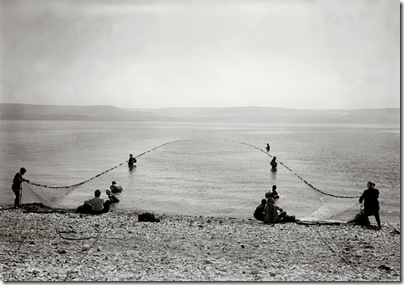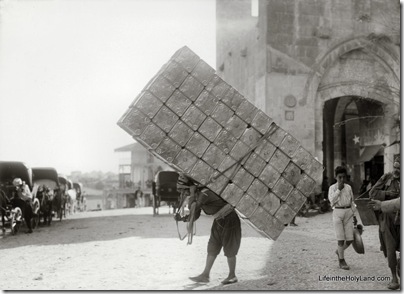Matthew 13:47-48 (NIV) “Once again, the kingdom of heaven is like a net that was let down into the lake and caught all kinds of fish. When it was full, the fishermen pulled it up on the shore. Then they sat down and collected the good fish in baskets, but threw the bad away.”
“The jarf or ‘drag net’ is as much as 400 metres long. In mesh it is as fine as the shabakeh. It is used at the Lake chiefly during daylight, but along the Bay of Acre many of these nets are employed after the sunset with lanterns and torches to illuminate the scene. The net is paid out of a boat in an immense semicircle, the two ends being near the shore. The upper side floats by means of corks, the lower is kept down by small lead weights. As soon as the net is in position the men on the shore commence the process of hauling it in. Four men, if possible, take charge of each extremity, they have long ropes fixed to the lower and upper corners so that they drag in the bottom at the same time as the top. In order that a steady and uninterrupted pull may be kept up they merely fix the ropes to their belts, and each man nearest the landward end of the ropes, as soon as there is room, leaves off his hold there and runs forward to seize the ropes at the net-end as they come in shore. The fishermen consider it a matter of importance that when once the net has commenced to come in, there should be no pause in its progress. As the centre parts begin to come into shallow water some of the fishermen assist its progress by jumping or diving into the water and lifting the weighted lower side over the large stones. This is particularly necessary at Tiberias, where there are many large stones all over the bottom. Finally the net reaches the shore, having ‘gathered of every kind’ (Matt. xiii, 48). Clearly the net here described was the draw net.” Source: E. W. G. Masterman, “The Fisheries of Galilee,” Palestine Exploration Fund Quarterly Statement (1908): 45.
The photo and quotation are taken from the Traditional Life and Customs volume of The American Colony and Eric Matson Collection (Library of Congress, LC-matpc-04570).

